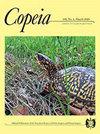Range Limits and Demography of a Mountaintop Endemic Salamander and Its Widespread Competitor
IF 2.6
Q2 Agricultural and Biological Sciences
引用次数: 1
Abstract
Range limits can be caused by a multitude of abiotic or biotic factors, but all of these must act through the demography of range-edge populations. Woodland salamanders of the genus Plethodon often exhibit distinct range boundaries where the distributions of competing species meet. Because of their high densities and low mobility, Plethodon are well suited for studies of how fitness-related traits change as species approach their range limits. Across contact zones between the mountaintop endemic Peaks of Otter Salamander (Plethodon hubrichti) and the widespread Eastern Redback Salamander (Plethodon cinereus), we measured changes in three salamander traits: 1) body condition, 2) frequency of tail loss, and 3) proportion of hatchlings. We then used hierarchical Bayesian models to compare these traits among five site types: allopatric sites for both species, sites where one of the species was dominant and the other was rare, and mixed sites containing high densities of both species. For P. hubrichti, we found no consistent changes in body condition across contact zones. However, frequency of tail loss increased continuously from allopatric sites (21%) to rare sites (54%). We also found evidence of reduced hatchling proportions at sites outside of allopatric areas (15–16% versus 30% at allopatric sites). For P. cinereus, body condition was higher at allopatric sites compared to sites within the contact zone. Similar to P. hubrichti, frequency of tail loss in P. cinereus increased continuously from allopatric sites (27%) to sites where P. cinereus were rare (50%). However, for P. cinereus, we did not find evidence of reduced hatchling numbers towards the edge of their range margin. Overall, our results suggest that both species likely have reduced fitness as they approach their range margin. Tail loss, which may reflect interference competition, effects of predation, or interactions between these, could potentially act as a density-dependent factor that stabilizes the range boundary between these species, at least over shorter time scales.一种山地特有蝾螈及其广泛竞争对手的活动范围和人口学特征
范围限制可能是由多种非生物或生物因素造成的,但所有这些因素都必须通过范围边缘种群的人口学来起作用。Plethodon属的林地蝾螈经常在竞争物种的分布交汇处表现出明显的范围边界。由于其高密度和低流动性,Plethodon非常适合研究适应度相关特征如何随着物种接近其范围限制而变化。在Otter Salamander(Plethodon hubrichti)和广泛分布的东部红背蝾螈(Plethoton cinereus)的山顶特有峰之间的接触区,我们测量了蝾螈三个特征的变化:1)身体状况,2)尾巴脱落的频率,3)孵化的比例。然后,我们使用层次贝叶斯模型在五种站点类型中比较这些特征:两个物种的异地站点,其中一个物种占优势而另一个物种稀少的站点,以及两个物种密度高的混合站点。对于胡布里奇蒂P.hubrichti,我们发现不同接触区域的身体状况没有一致的变化。然而,从异位位点(21%)到罕见位点(54%),尾部丢失的频率不断增加。我们还发现,在异地地区以外的地区,孵化率降低(15-16%,而异地地区为30%)。对于灰蝶,与接触区内的部位相比,异地部位的身体状况更高。与胡氏灰蝶相似,灰蝶尾部缺失的频率从异地(27%)持续增加到灰蝶罕见的地方(50%)。然而,对于灰蝶,我们没有发现孵化数量在其范围边缘减少的证据。总的来说,我们的研究结果表明,当这两个物种接近它们的活动范围时,它们的适应度可能会降低。尾部损失可能反映了干扰竞争、捕食效应或它们之间的相互作用,可能是一个密度依赖因素,至少在较短的时间尺度上稳定了这些物种之间的范围边界。
本文章由计算机程序翻译,如有差异,请以英文原文为准。
求助全文
约1分钟内获得全文
求助全文
来源期刊

Copeia
生物-动物学
CiteScore
2.10
自引率
0.00%
发文量
0
审稿时长
6-12 weeks
期刊介绍:
Founded in 1913, Copeia is a highly respected international journal dedicated to the publication of high quality, original research papers on the behavior, conservation, ecology, genetics, morphology, evolution, physiology, systematics and taxonomy of extant and extinct fishes, amphibians, and reptiles. Copeia is published electronically and is available through BioOne. Articles are published online first, and print issues appear four times per year. In addition to research articles, Copeia publishes invited review papers, book reviews, and compiles virtual issues on topics of interest drawn from papers previously published in the journal.
 求助内容:
求助内容: 应助结果提醒方式:
应助结果提醒方式:


